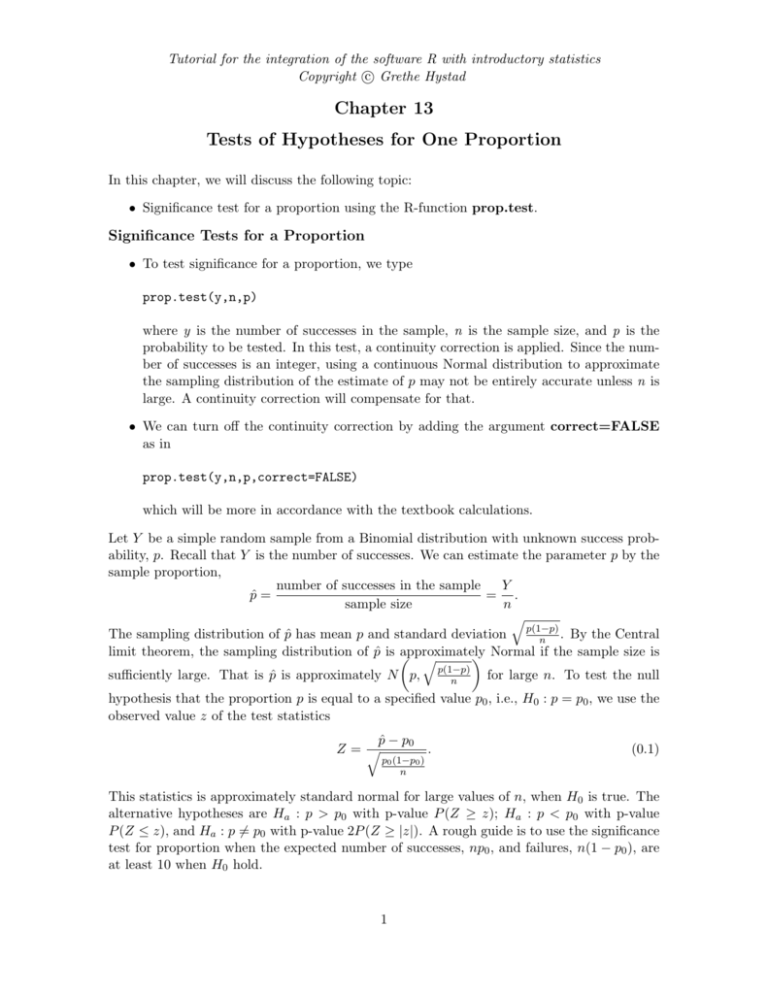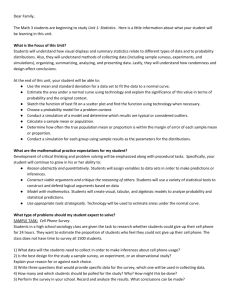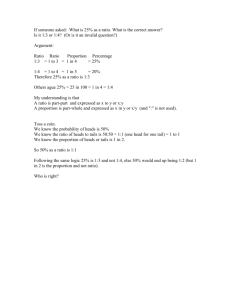Chapter 13 Tests of Hypotheses for One Proportion
advertisement

Tutorial for the integration of the software R with introductory statistics c Grethe Hystad Copyright Chapter 13 Tests of Hypotheses for One Proportion In this chapter, we will discuss the following topic: • Significance test for a proportion using the R-function prop.test. Significance Tests for a Proportion • To test significance for a proportion, we type prop.test(y,n,p) where y is the number of successes in the sample, n is the sample size, and p is the probability to be tested. In this test, a continuity correction is applied. Since the number of successes is an integer, using a continuous Normal distribution to approximate the sampling distribution of the estimate of p may not be entirely accurate unless n is large. A continuity correction will compensate for that. • We can turn off the continuity correction by adding the argument correct=FALSE as in prop.test(y,n,p,correct=FALSE) which will be more in accordance with the textbook calculations. Let Y be a simple random sample from a Binomial distribution with unknown success probability, p. Recall that Y is the number of successes. We can estimate the parameter p by the sample proportion, number of successes in the sample Y p̂ = = . sample size n q The sampling distribution of p̂ has mean p and standard deviation p(1−p) n . By the Central limit theorem, the sampling distribution of p̂ is approximately Normal if the sample size is q p(1−p) n sufficiently large. That is p̂ is approximately N p, for large n. To test the null hypothesis that the proportion p is equal to a specified value p0 , i.e., H0 : p = p0 , we use the observed value z of the test statistics p̂ − p0 Z=q . (0.1) p0 (1−p0 ) n This statistics is approximately standard normal for large values of n, when H0 is true. The alternative hypotheses are Ha : p > p0 with p-value P (Z ≥ z); Ha : p < p0 with p-value P (Z ≤ z), and Ha : p 6= p0 with p-value 2P (Z ≥ |z|). A rough guide is to use the significance test for proportion when the expected number of successes, np0 , and failures, n(1 − p0 ), are at least 10 when H0 hold. 1 An approximate 100(1 − α)% confidence interval for p is r p̂(1 − p̂) p̂ ± z ∗ , n (0.2) where the critical value z ∗ is chosen such that the area under the normal density curve between −z ∗ and z ∗ is (1 − α). In order to use this confidence interval, the numbers of successes and failures should both be at least 15 [3]. Problem. The Trial Urban District Assessment (TUDA) is a study sponsored by the government of student achievement in large urban school districts. The math test-score is on a scale from 0 to 500. A ”basic” math level is a score of 262, a ”proficient” level is a score of 299, and a ”advanced” level is a score of 333. In 2011, between 1,000 and 2,700 fourth- and eighth-graders from public schools in 21 urban districts participated in the NAEP TUDA in mathematics [1]. In 2011, 792 of a random sample of 1200 eighth-graders in San Diego scored above the Basic level in mathematics. In large public city, 63% scored above the Basic level in mathematics [2]. (The study reports the proportions). (A) Is the proportion of eighth-graders who scored above the Basic level in mathematics in San Diego significantly larger than 0.63 at the 5% level? (B) Calculate a 99% confidence interval for the proportion of eight-graders who scored above the Basic level in mathematics in San Diego. Solution to part (a). Let p be the proportion of eighth-graders in San Diego that scored above the Basic level in mathematics. We wish to test the null hypothesis that the proportion p is equal to 0.63 against the alternative hypothesis that p is greater than 0.63. That is, we wish to test H0 : p = 0.63 against Ha : p > 0.63. We obtain: > prop.test(792,1200,0.63,alternative=c("greater"),correct=FALSE) 1-sample proportions test without continuity correction data: 792 out of 1200, null probability 0.63 X-squared = 4.6332, df = 1, p-value = 0.01568 alternative hypothesis: true p is greater than 0.63 95 percent confidence interval: 0.6371695 1.0000000 sample estimates: p 0.66 Since the p-value is 0.01568 < 0.05, we reject the null hypothesis at the 5% level. Thus, we have strong evidence that the proportion of eighth-graders who scored above the Basic level in mathematics in San Diego is greater than 0.63. 2 Solution to part (b). We first calculate the confidence interval using the textbook formula in (0.2): We have 0.99 + (1 − 0.99)/2 = 0.995, so we wish to find z ∗ such that P (Z ≤ z ∗ ) = 0.995. We obtain: > phat=792/1200 > z=qnorm(0.995) > conf=c(phat-z*sqrt((phat*(1-phat))/1200),phat+z*sqrt((phat*(1-phat))/1200)) > conf [1] 0.6247761 0.6952239 The 99% confidence interval for the proportion of eighth-graders who scored above the Basic level in mathematics in San Diego is (0.625, 0.695). Thus, we are 99% confident that the percent of eighth-graders who scored above the Basic level in mathematics in San Diego is between 62.5% and 69.5%. If we do this calculation in R, we obtain: > prop.test(792,1200, conf.level=0.99,correct=FALSE) 1-sample proportions test without continuity correction data: 792 out of 1200, null probability 0.5 X-squared = 122.88, df = 1, p-value < 2.2e-16 alternative hypothesis: true p is not equal to 0.5 99 percent confidence interval: 0.6239822 0.6942582 sample estimates: p 0.66 R obtains a slightly different result due to the fact that R uses a different method for calculating confidence intervals for one proportion. Explanation. The code can be explained as follows: • The prop.test in R computes a chi-squared statistic, X -squared, (see chapter 22 for the definition of chi-squared statistics). This test is equivalent to the z-test when you √ take its square root, that is, z = 4.6332 = 2.152487. • We added the argument correct=FALSE to turn off the continuity correction such that the z statistics is equivalent to the textbook formula in (0.1). References [1] National Assessment of Educational Progress, National Center for Education Statistics, National Assessment Governing Board, Institute of Education Sciences, U.S. Department of Education at http://nationsreportcard.gov/tuda.asp [2] National Center for Education Statistics, The Nation’s Report Card, Mathematics 2011, Trial Urban District Assessment, Results at grades 4 and 8, Institute of Education Sciences, U.S. Department of Education, NCES 2012-452. 3 [3] D. S. Moore, W. I. Notz, M. A. Fligner, R. Scoot Linder. The Basic Practice of Statistics. W. F. Freeman and Company, New York, 2013. 00 4







